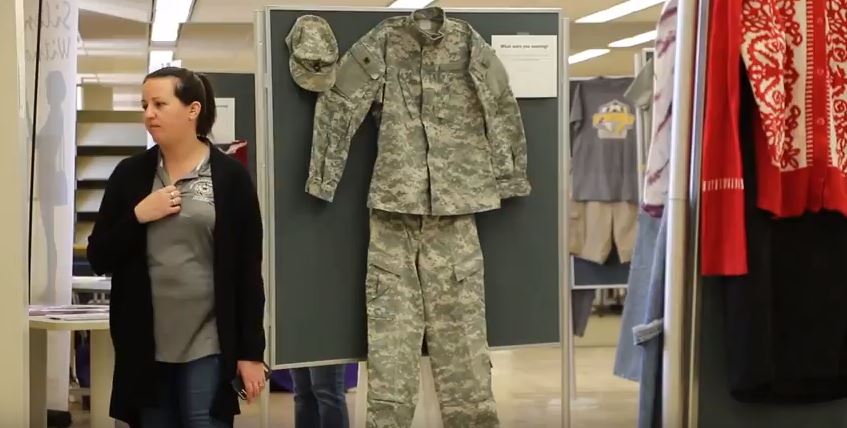BY SHEA HARPER
Sexual assault survivors are taking back the words too often used to discredit them: “What were you wearing?”
They display their answers in the form of pajamas, a bikini, a red dress, and a T-shirt and jeans in an art exhibit to fight the blame that was put on them.
The “What Were You Wearing” Survivor Art Installation was displayed Wednesday, April 18 through Friday, April 20 at the Hays Arts Center Annex and on the main floor of FHSU’s Forsyth Library Tuesday, April 24 and Wednesday, April 25 in honor of Sexual Assault Awareness Month.
It featured 18 stories of sexual assault and depictions of what each victim was wearing when they were attacked alongside small white signs describing what they wore – in their own words.
“My favorite yellow shirt,” reads one sign that hangs beside a youth sized top. “I don’t remember what pants I was wearing.”
“It was always the same outfit,” reads a second. “White T-shirt and basketball shorts. It was always after rec center league. I trusted him. My mom trusted him.”
A red and pink striped sundress hangs on the wall alongside the words — “My mother would stand in front of my closet and complain about how I never wore any of my dresses anymore. I was six years old.”
The Women’s Leadership Project at Fort Hays partnered with Jana’s Campaign and Options Domestic and Sexual Violence Services to host the exhibit.
Hollie Marquess, an instructor in the Department of History at FHSU and the director for the Women’s Leadership Project, helped to curate the event.
“Options reached out to WLP wanting to lead the effort to bring this exhibit to Hays. Jana’s Campaign is the perfect community partner for this type of event as well,” said Marquess. “They travel all over the country educating individuals of all ages and stations in life about domestic and sexual violence. Their advocacy work is crucial, not only to this exhibit, but to reducing gender-based violence.”
Marquess believes the community will benefit from this piece.
“When I first learned of this exhibit last year, the story that struck me the most involved a male college student. This exhibit shines a light on male victims of sexual violence, which is something the community of Hays needs to be cognizant of,” said Marquess. “We’ve chosen stories of rape victims that we feel will resonate with our campus community.
“Rape culture is pervasive and unfortunately, victim blaming is rampant. Hopefully, viewers of the art installation will come away with a greater understanding of victim blaming and its devastating consequences on survivors of sexual violence.”
The art installation originated at the University of Arkansas in 2013. The project was created by Jen Brockman, the director of Sexual Assault Prevention and Education Center at the University of Kansas, and Dr. Mary Wyandt-Hiebert, who works at the University of Arkansas’ rape education center overseeing programming initiatives. They were inspired to create a visual representation of the poem by Dr. Mary Simmerling titled What I Was Wearing.
The two told the KU Sexual Assault Prevention and Education Center their intent for the installation.
Dr. Wyandt-Hiebert and Ms. Brockman wanted to create a project that would place the work of bearing witness to this question’s answer on the shoulders of the community and humanize the survivor in the answer.
They wanted to challenge participants to engage in the connection we all have with clothing and to reflect on what gives this specific rape culture myth so much power. Marquess explains how she’s hoping people will react to the gallery.
“We are hoping to dispel the myth that what someone was wearing plays a role in sexual violence,” said Marquess. “Rapists cause rape. A person’s clothes do not invite rape. Ever. Education is such a key component to prevention work, so it is our hope that viewers of the art installation will read the survivors’ stories paired with the visual image of clothing and leave with a decreased tendency to victim blame.”
The installation asks participants to understand that it was never about the clothing and that shedding those clothes is not enough to bring peace to survivors. If only it was as easy as changing our clothes to end sexual violence. It requires us to examine what allowed us to ask, “What were you wearing?” in the first place

